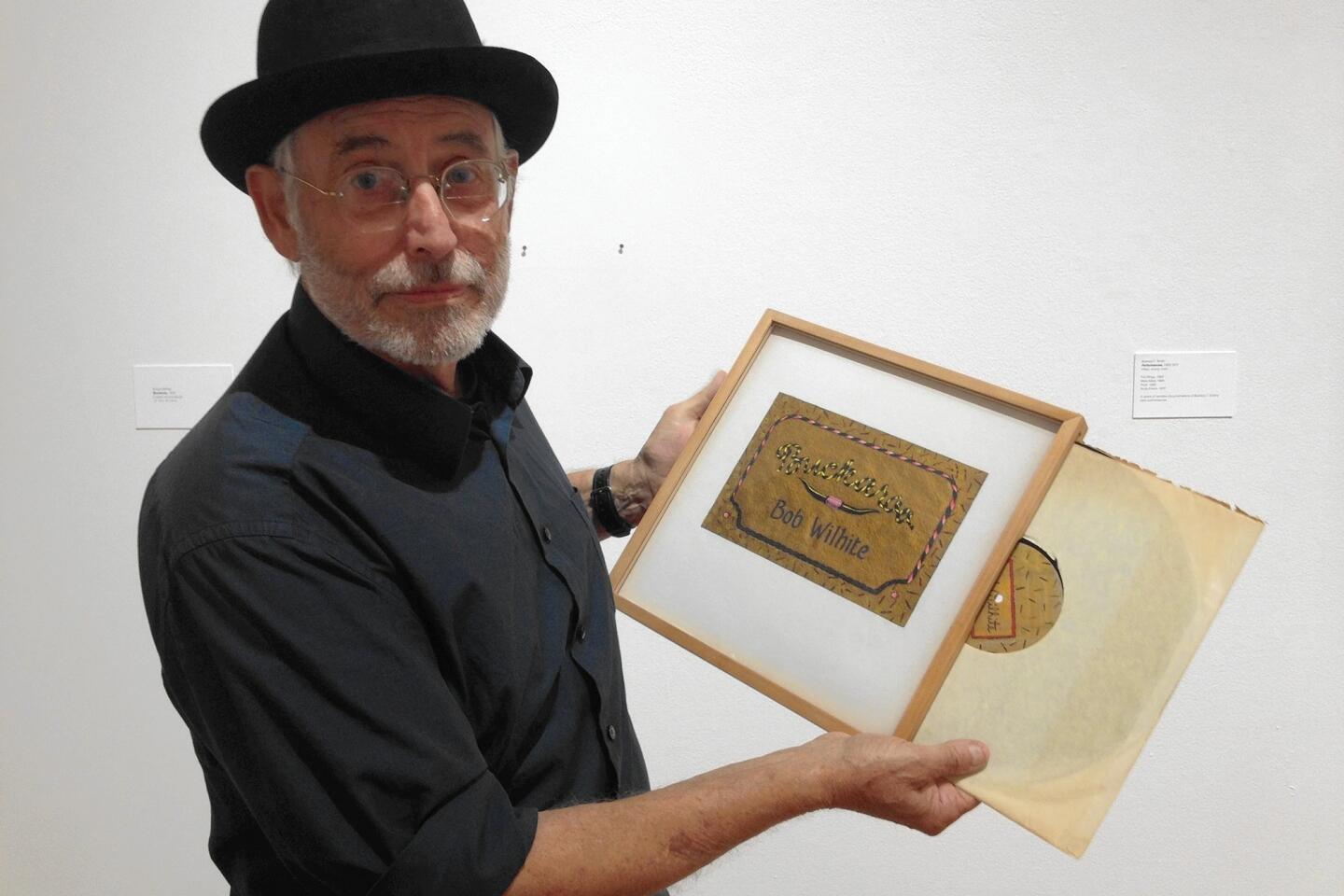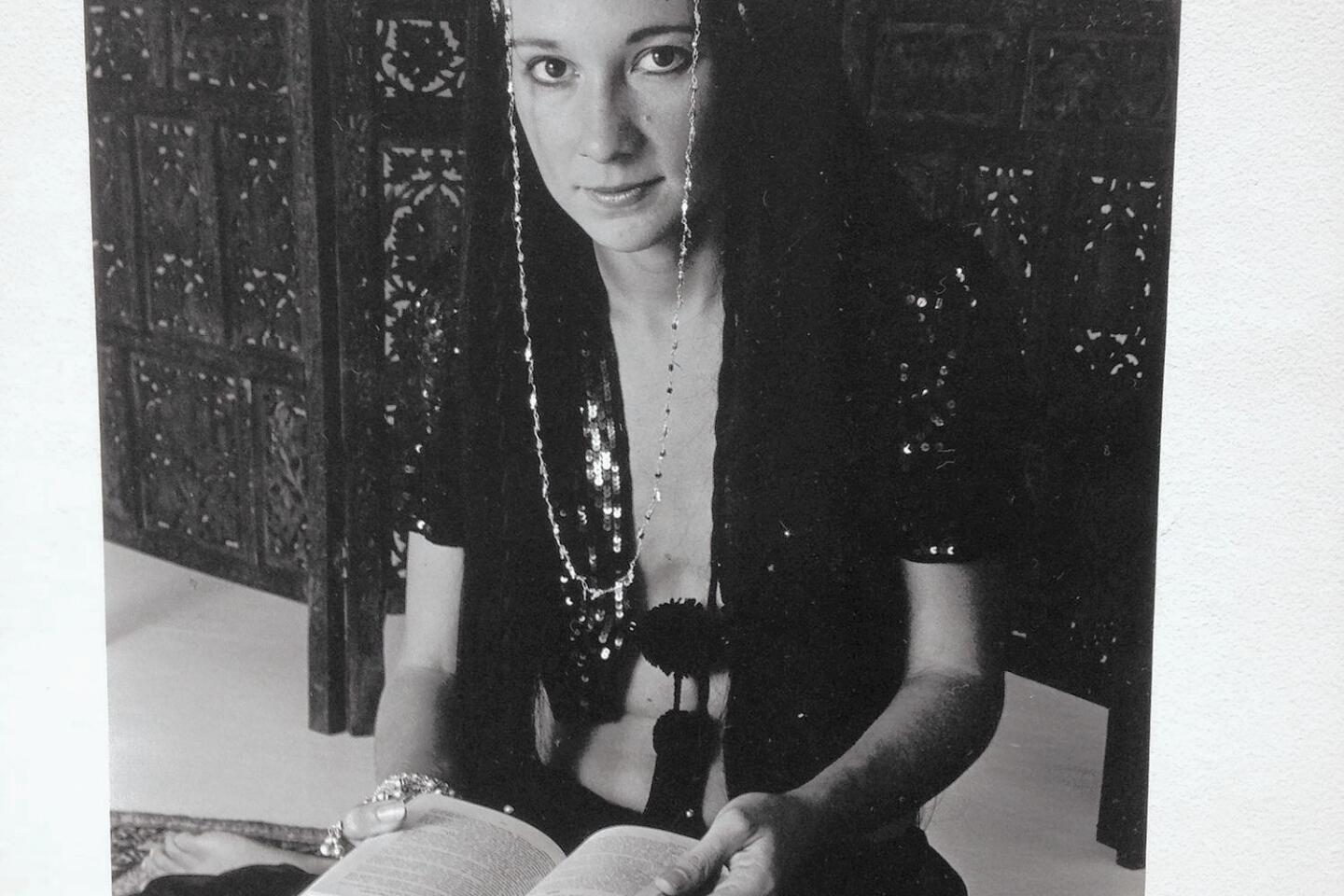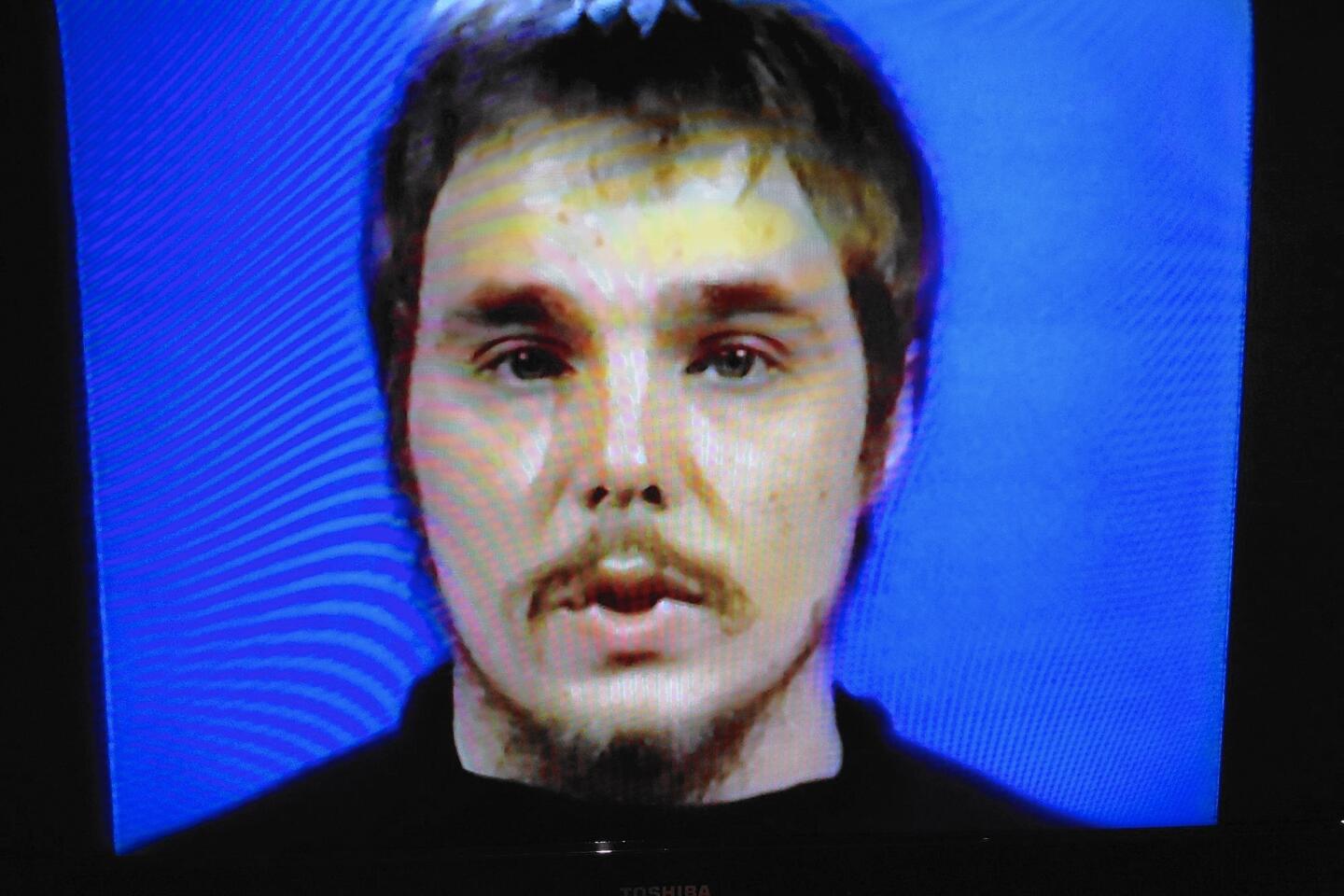UC Irvine exhibit captures a significant, homegrown period in art history
- Share via
In November 1971, a young UC Irvine art graduate student, Chris Burden, had himself shot in the arm with a .22 rifle in the performance piece, “Shoot.” The shot heard around the art world took place at F Space Gallery in Santa Ana. Though shocking by itself, it wasn’t the only boundary-breaking performance that came out of the budding art school in the middle of nowhere.
Through Dec. 12, the University Art Gallery at UCI is presenting “A Performative Trigger: Radicals of Irvine.” The group exhibition features works by Burden, Nancy Buchanan, Richard Newton, Alexis Smith, Barbara T. Smith, Bradley Smith, Paula Sweet and Robert Wilhite, as well as ephemera by and about these influential UC Irvine-trained artists.
The show, co-curated by Juli Carson and Marilyn Nix, is part of UC Irvine’s 50th anniversary celebration. It also takes place just months after the death of Burden — the creator of the popular “Urban Light” sculpture in front of the Los Angeles County Museum of Art died on May 10 at 69 after being diagnosed with melanoma.
“We would have wanted to do [the exhibition] because of Burden’s passing, but it’s also pretty coincidental, because we were trying to make decisions on a number of things for fall,” said Carson, a UCI professor of art history and director of the University Art Galleries.
This exhibit, she said, is “a trigger to consider the early decades of this university and how its sensibility produced one of the most famous performance artists in the world.”
“A Performative Trigger” follows in the footsteps of “Best Kept Secret: UCI and the Development of Contemporary Art in Southern California, 1964-1971,” shown at Laguna Art Museum between October 2011 and January 2012. That groundbreaking exhibition was part of the sweeping Getty-sponsored initiative, “Pacific Standard Time,” which explored art made in Los Angeles and Southern California between 1945 and 1980.
The new UCI exhibition focuses on the early 1970s, when Irvine was still dominated by open, undeveloped space and the fledgling UC Irvine campus was still being constructed. The art school, too, was still in its early development, though it had attracted some big names in the art world as instructors — Tony DeLap, David Hockney, Larry Bell, Craig Kauffman, Robert Irwin, Vija Celmins, John Mason, John McCracken, Ed Moses and John Coplans, founder and editor of Artforum magazine.
Because of the lack of materials and studio space, teachers and students were forced to think outside the box and create art out of what was accessible — everyday, mundane materials such as aluminum cans and trash and their own bodies.
I was interested in changing something and making it into its opposite. ... I was taking something that could be considered pornographic, then trying to really cool it down.
— -Nancy Buchanan, UC Irvine-trained artist
“The economy of means is what gave birth to this,” Carson said. “There were no resources or studios on campus. The situation actually made them push the limit on what might be considered art.”
As students and teachers were redefining art and challenging the status quo on the island of UC Irvine, the region surrounding them became known for its conservatism and for being the birthplace and stomping ground of then-President Richard Nixon.
*
‘ART WAS ... NOT AN OBJECT, EVER’
Nancy Buchanan was an 18-year-old single mother from Laguna Beach when she started her undergraduate years at UCI. Her parents died at a young age and so did her grandmother, who had helped raise her.
“I was a single young parent without any parents,” she said. “School was kind of my salvation. I think there were a number of people and events that were extremely influential.
“The ideas of Robert Irwin were revolutionary in terms of understanding what art was, that it was not an object, ever. It was experience. And that you considered the entire environment that surrounded the work of art as well.”
Buchanan’s contributions to “Performative Trigger” include “Twin Corners” (1975), a pile of metal shavings and a photograph that depict a woman’s private anatomy; “From Dreams” (1974-77), a series of pencil and pastel drawings with surreal, incongruous juxtapositions; and a pencil-and-pastel series called “Hard into Soft” (1971-72) that features some rather explicit sexual situations.
“I was interested in changing something and making it into its opposite,” said Buchanan, now 69. “I took photos that were hard and hot and made them soft. I was taking something that could be considered pornographic, then trying to really cool it down.”
Buchanan said her works did not offend viewers, even when she first showed them in 1971. “People got it. They understood it.”
*
TURNING TRASH INTO ART
Richard Newton helped redefine art by putting things in the gallery that hadn’t been placed there before — food waste, aluminum cans and shards of glass. He once pretended to be a pageant queen who underwent a sex change operation, and invited a gallery audience to touch his exposed private parts as he stood behind a white sheet.
“When I got here, and I started meeting these other artists, it was sort of the first time for me that I actually felt like I was with kindred spirits,” said Newton, who attended UC Irvine from about 1968 to 1973. Like Buchanan, he obtained both undergraduate and graduate degrees from UCI.
“I never thought of it as unusual, or this is weird,” he said of his work and the activities of his colleagues. “I guess we just had fun.”
While he was a student at UCI, Newton spent a couple of years living in a garage or crashing in instructors’ offices and finding food in the dumpsters behind supermarkets.
“We were poor, that’s for sure, but we were resourceful,” said Newton, 67. “In America, we just throw so much away. I lived a very resourceful life in the world, and there were things that I learned, that I felt like I needed to let people know.”
On view in the University Art Gallery are Newton’s cans installation, “Cantina” (1972), and four short films he created when he was a student. Several photographs and text panels document his many outlandish performance pieces.
*
WHAT IS ART?
Robert Wilhite attended UC Irvine from 1965 to 1970 as an undergraduate. He started in the MFA program there in 1971, but left for a job at Pace Gallery in New York.
At UCI, Wilhite learned that art was about the concept and creating an image in people’s minds. It wasn’t necessarily about producing pretty pictures.
“All of us realized early on: The discussion about what is and what is not art is a much better discussion than whether a piece of art is a good painting or whatever,” he said.
Wilhite’s work in the show includes “Silent Harp” (1978), in which the live, spoken description of the instrument’s sound is the actual music; a two-sided, handcrafted vinyl record and case called “Buckaroo” (1976); and photos of his performance pieces.
As part of his artistic practice, Wilhite performed a stringed instrument over the telephone to callers responding to ads placed in Los Angeles and San Francisco; he described works of art that didn’t exist over the telephone; and he threw a hand-made glider from the top of the Empire State Building and offered $20 to whoever returned it. One photo captures Wilhite, Burden and a taxi driver admiring the slightly banged-up glider on the streets of New York.
“I really felt that Chris was like a brother to me for a number of years,” said Wilhite, 69, now a resident of Hawthorne. “We both had a passion for airplanes and things that flew. Throughout our friendship, we’d always give things to each other.”
Wilhite, who shared an apartment with Burden for a number of years, heard about his friend’s death while he was on a trip to Amsterdam. The news surprised and saddened him.
“It really affected me, because first of all, he was really, really a dear friend, and we had been through some hard times and good times together. Besides being such a powerful presence in this show and his artwork and everything else, Chris came to the party with a lot of things that the rest of us didn’t. And all of us appreciated Chris’ presence.”
Burden’s presence can certainly be felt in “A Performative Trigger.” A number of his inventive videos are on view, as well as magazine articles and ephemera documenting his performances and his productive, trendsetting time at UC Irvine.
*
IF YOU GO
What: ‘A Performative Trigger: Radicals of Irvine’
Where: University Art Gallery, 712 Arts Plaza, Irvine
Hours: Noon-6 p.m. Tuesdays-Saturdays
Cost: Free
Info: (949) 824-9854; arts.uci.edu
More to Read
The biggest entertainment stories
Get our big stories about Hollywood, film, television, music, arts, culture and more right in your inbox as soon as they publish.
You may occasionally receive promotional content from the Los Angeles Times.















